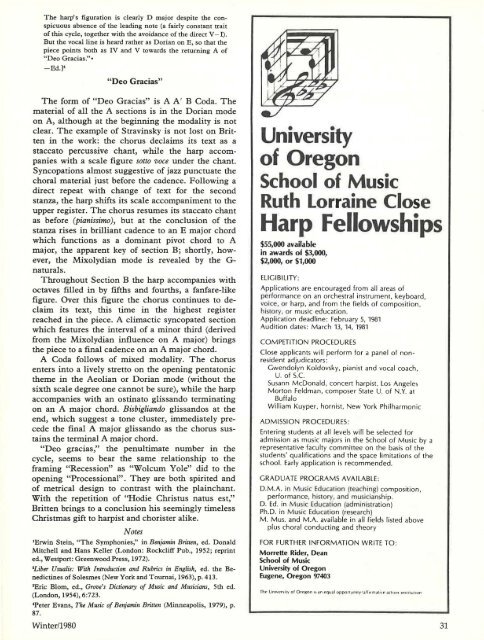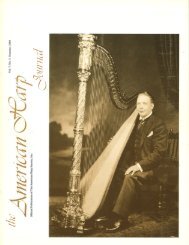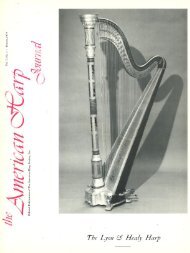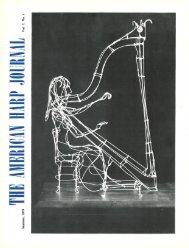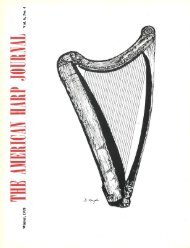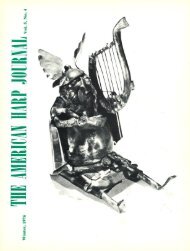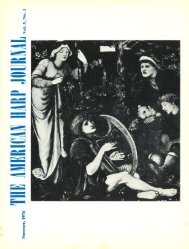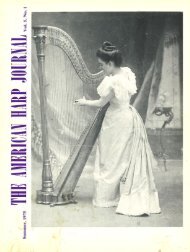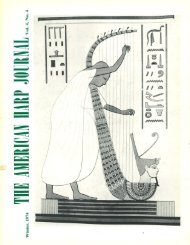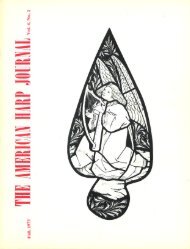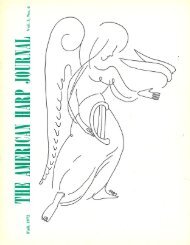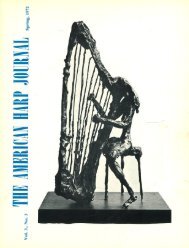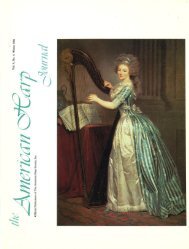Create successful ePaper yourself
Turn your PDF publications into a flip-book with our unique Google optimized e-Paper software.
The harp's figuration is clearly D major despite the conspicuous<br />
absence of the leading note (a fairly constant uait<br />
of this cycle, together with the avoidance of the direct V -1).<br />
But the vocal line is heard rather as Dorian on E, so that the<br />
piece points both as IV and V towards the returning A of<br />
"Deo Gracias."•<br />
-Ed.] 4<br />
"Deo Gracias"<br />
The form of "Deo Gracias" is A A' B Coda. The<br />
material of all the A sections is in the Dorian mode<br />
on A, although at the beginning the modality is not<br />
clear. The example of Stravinsky is not lost on Britten<br />
in the work: the chorus declaims its text as a<br />
staccato percussive chant, while the harp accompanies<br />
with a scale figure sotto voce under the chant.<br />
Syncopations almost suggestive of jazz punctuate the<br />
choral material just before the cadence. Following a<br />
direct repeat with change of text for the second<br />
stanza, the harp shifts its scale accompaniment to the<br />
upper register. The chorus resumes its staccato chant<br />
as before (pianissimo), but at the conclusion of the<br />
stanza rises in brilliant cadence to an E major chord<br />
which functions as a dominant pivot chord to A<br />
major, the apparent key of section B; shortly, however,<br />
the Mixolydian mode is revealed by the G<br />
naturals.<br />
Throughout Section B the harp accompanies with<br />
octaves filled in by fifths and fourths, a fanfare-like<br />
figure. Over this figure the chorus continues to declaim<br />
its text, this time in the highest register<br />
reached in the piece. A climactic syncopated section<br />
which features the interval of a minor third (derived<br />
from the Mixolydian influence on A major) brings<br />
the piece to a final cadence on an A major chord.<br />
A Coda follows of mixed modality. The chorus<br />
enters into a lively stretto on the opening pentatonic<br />
theme in the Aeolian or Dorian mode (without the<br />
sixth scale degree one cannot be sure), while the harp<br />
accompanies with an ostinato glissando terminating<br />
on an A major chord. Bisbigliando glissandos at the<br />
end, which suggest a tone cluster, immediately precede<br />
the final A major glissando as the chorus sustains<br />
the terminal A major chord.<br />
"Deo gracias," the penultimate number in the<br />
cycle, seems to bear the same relationship to the<br />
framing "Recession" as "Wolcum Yole" did to the<br />
opening "Processional". They are both spirited and<br />
of metrical design to contrast with the plainchant.<br />
With the repetition of "Hodie Christus natus est,"<br />
Britten brings to a conclusion his seemingly timeless<br />
Christmas gift to harpist and chorister alike.<br />
<strong>No</strong>tes<br />
'Erwin Stein, "The Symphonies," in Benjamin Britten, ed. Donald<br />
Mitchell and Hans Keller (London: Rockcliff Pub., 1952; reprint<br />
ed., Westport: Greenwood Press, 1972).<br />
'Liber Usualis: With Introduction and Rubrics in English, ed. the Benedictines<br />
of Solesmes (New York and Tournai, 1963), p. 413.<br />
3<br />
Eric Blom, ed., Grove's Dictionary of Music and Musicians, 5th ed.<br />
(London, 1954), 6:723.<br />
4<br />
Peter Evans, The Music of Benjamin Britten (Minneapolis, 1979), p.<br />
87.<br />
<strong>Winter</strong>/<strong>1980</strong><br />
University<br />
of Oregon<br />
School of Music<br />
Ruth Lorraine Close<br />
Harp Fellowships<br />
$55,000 available<br />
in awards of $3,000,<br />
$2,000, or $1,000<br />
ELIGIBILITY :<br />
Applications are encouraged from all areas of<br />
performance on an orchestral instrument, keyboard,<br />
voice, or harp, and from the fields of composition,<br />
history, or music education.<br />
Application deadline: February 5, 1981<br />
Audition dates : March 13, 14, 1981<br />
COMPETITION PROCEDURES<br />
Close applicants will perform for a panel of nonresident<br />
adjudicators :<br />
Gwendolyn Koldovsky, pianist and vocal coach,<br />
U. of S.C.<br />
Susann McDonald, concert harpist, Los Angeles<br />
Morton Feldman, composer State U. of N.Y. at<br />
Buffalo<br />
William Kuyper, hornist, New York Philharmonic<br />
ADMISSION PROCEDURES:<br />
Entering students at all levels will be selected for<br />
admission as music majors in the School of Music by a<br />
representative faculty committee on the basis of the<br />
students' qualifications and the space limitations of the<br />
school. Early application is recommended.<br />
GRADUATE PROGRAMS AVAILABLE:<br />
D.M .A. in Music Education (teaching) composition,<br />
performance, history, and musicianship.<br />
D. Ed. in M usi•c Ed uca tion (admi nistration)<br />
Ph.D. in M usic Education (resea rch)<br />
M . Mus. and M.A. ava ilable in all fields listed above<br />
plus choral conducting and theory<br />
FOR FURTHER INFORMATION WRITE TO:<br />
Monette Rider, Dean<br />
School of Music<br />
University of Oregon<br />
Eugene, Oregon 97403<br />
Th e Un1versi1y o f OrC"1


